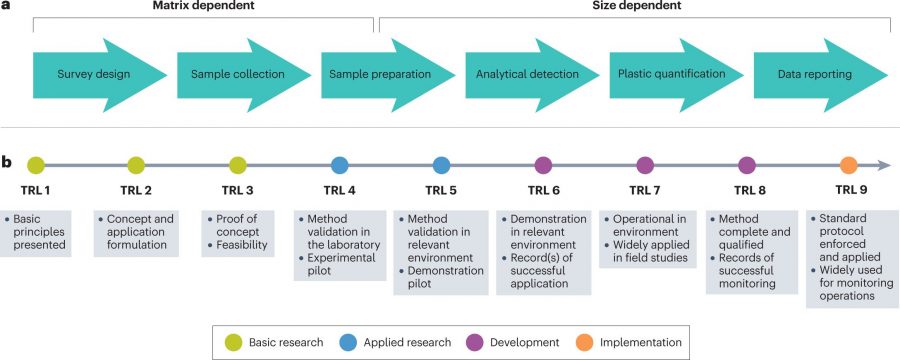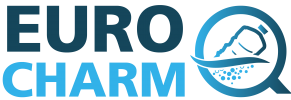Publication EUROqCHARM advances featured in Nature reviews earth & environment
EUROqCHARM researchers published an article in Nature Reviews Earth & Environment titled "Reproducible pipelines and readiness levels in plastic monitoring". Plastic monitoring urgently requires harmonisation of methodologies and validated protocols based on robust and reliable methods. They proposed to enhance the validation and assessment of monitoring guidelines using a new tool based upon Technological Readiness levels and Reproducible Analytical Pipelines.
Our objective is to highlight a critical need in plastic research and monitoring, and to suggest a robust and replicable approach to improve monitoring guidelines.
Plastic pollution is everywhere around the world. So how do you count plastics and observe changes or trends over time? Research is awash with many different methods and approaches to quantify and characterize plastic occurrence globally. But this has resulted in an overwhelming diversity of approaches: urgently requiring a system to validate their use. Some level of organisation is needed to gather comparable data. As the world works towards netotiating The Global Plastic Treaty, the international community will benefit from simple and adaptable ways to address this complex problem.
As for any environmental assessment, there is a need for sound monitoring methods, selected by objective and well-defined criteria, and most importantly they must be built on validated scientific knowledge. An approach that accelerates the decision-making processes for monitoring and regulation will also support high scientific standards and common ground for promoting best methods within research.
To support decision-making in this process, researchers involved in an EU Horizon 2020 project, EUROqCHARM (EUROpean quality Controlled Harmonization Assuring Reproducible Monitoring and assessment of plastic pollution) introduce the concept of Technological Readiness Levels (TRLs) applied to Reproducible Analytical Pipelines (RAPs) for plastic monitoring (see figure and nerd box). Combining these approaches with the assessment of environmental plastics is a much-needed innovative development. It is a significant step in supporting decision-making and is a ground-breaking approach for defining monitoring guidelines based on reproducible, harmonized, and comparable methods.
Reproducible Analytical Pipelines (RAPs) and Technological Readiness Levels (TRLs) enable systematic validation and global harmonization of plastic pollution monitoring methods. The use of these approaches is intended to provide a framework for discussion and eventually support action plans..
The combination of TRLs and RAPs is applied to the science of plastic pollution for the first time and the publication showcases the potential of this integration as a tool for systematic description of analytical procedures for plastics in the environment. This framework is a fundamental decision-making support tool, and the application of this logic potentially extends far beyond the issue of plastic pollution.

Combining TRLs and RAPs is new and forward-looking, and provides notable progress in the development of environmental research, monitoring knowledge, and technology. Off-the-shelf methods have been merged into a new perspective by focusing on specific and very critical aspects of research and monitoring plastic pollution, but the approach can be applied to many other monitoring cases and seen as a new concept for environmental research and monitoring.
Traditionally, guidelines consider plastic pollution assessments as a unique and solid path dedicated to a sample type or plastic size. When new knowledge or technologies become available, a new full guideline must be implemented, which can be more expensive and time-consuming than updating the new part. A solution to this problem is urgently needed.
All steps in an analytical method (incl. survey design, sample collection, sample preparation, analytical detection, quantification, and data reporting) are described for the first time as a RAP in plastic pollution monitoring and assessment. Each element of a RAP can be assessed for Technological Readiness Levels (TRLs) following an approach first developed by NASA for space technology. Until now, TRL has been poorly applied to environmental science, and never to plastic pollution monitoring processes. TRL has immense potential to support decision making on national, regional and international levels. TRLs can help distinguish which methods, or parts of a method, that are at a level which is mature enough to consider them for large-scale monitoring guidelines from those that need to be redirected into research and development (such as investigating microplastics in air). Robust and replicable information is extracted.
RAPs and TRL are combined and used for a systematic validation and global harmonization of plastic pollution monitoring methods. The overall readiness rating of fundamental steps of the RAP provides expert groups, regulators, and stakeholders with a powerful and flexible decision-making tool to support plastic and other pollutant action plans.
The idea is based upon the work carried out in the EUROqCHARM EU project and the authors are part of the project. The work was based on a systematic review of more than 3000 articles in the field of plastic litter.
Nerd Box |
| Reproducible analytical pipelines (RAPs) – are used to improve the reproducibility of analysis. Until now, they have been used most commonly through a system’s engineering approach. The concept can be applied to the system of plastic pollution monitoring and assessment by breaking down the core concepts in the analytical approach: survey design, sample collection, sample preparation, analytical detection, quantification, and data reporting. |
| Technological readiness levels (TRLs) – are a method that can be applied to estimate the maturity of a technology. They have become innovative policy tools applied in the European Union (Commission Decision C (2017)7124). |
Zenodo community
For access to the author’s manuscript, read-only published version and full reference of the article please visit our Zenodo community. EUROqCHARM will make available the systematic review on which the Nature Review article is based upon in here soon too.
